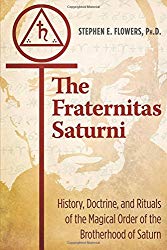
The Fraternitas Saturni: History, Doctrine, and Rituals of the Magical Order of the Brotherhood of Saturn, By Stephen E. Flowers
Inner Traditions, 9781620557211, 224 pp., 2018
From the primordial soup of Freemasonry and the Rosicrucians spawned the Hermetic Order of the Golden Dawn, which in turn spawned orders such as the Bavarian Illuminati, Grand Pansophical Lodge, the Original Hermetic Brotherhood of Light, the Theosophical Society, the Ordo Templi Orientis (OTO), and the Fraternitas Saturni, as we learn in The Fraternitas Saturni: History, Doctrine, and Rituals of the Magical Order of the Brotherhood of Saturn.
These organizations are often referred to as brotherhoods, but they don’t use this term in the ordinary or collegiate sense. The Fraternitas Saturni’s use of the term “brotherhood” is not an attempt to exclude women, in fact, the book states that women are viewed as equal members. The Fraternitas Saturni is a brotherhood in the sense that the bonds forged by the order and the initiate are designed to transcend our material world and be carried into the soul’s next incarnation. They are also formed on the astral, or mental, plane. In this way, all of the members are connected in a spiritual fraternity, and a larger tapestry is interwoven over various planes of existence, lifetimes and incarnations.
The Fraternitas Saturni: History, Doctrine, and Rituals of the Magical Order of the Brotherhood of Saturn by Stephen E. Flowers is the fourth revised and enlarged edition and it explains the concepts of the origins and organization of the Fraternitas Saturni unpretentiously, without diminishing the greater depths of the system in any way. Within the pages of this book, Flowers briefly outlines a rich history that includes the likes of Eliphas Levi, Jacob Boehme, Józef Maria Hoene-Wroński, Theodor Reuss, Aleister Crowley, and many more great names in science, magick, and mysticism.
The Fraternitas Saturni seems to be a hybrid mix of astrology, cosmology, masonic principles and Golden Dawn-styled ceremonial magick, with a dash of Thelema and Aleister Crowley tossed into the mix. Yet, the Fraternitas Saturni is different than many of the hermetic magick orders that exist today. Flowers explains just what makes the Fraternitas Saturni unique among this vast world of quasi-masonic orders.
One significant difference is that the Fraternitas Saturni is both a teaching order and a social order. While many of these masonic-styled organizations emphasize either one or the other, the Fraternitas Saturni place a tremendous amount of importance on both group ritual as well as the personal work of each individual. Everyone knows that it is only through the disciplined practices of the individual, accomplished in secret, that enlightenment occurs, but the social aspect can be essential as well. Many valuable lessons can be learned through the social elements of fraternal organizations. Though the path of the initiate is a solitary one, the order assists the members by keeping the social aspect of the organization, as well as group rituals, firmly in place. The Fraturnitas Saturni is one organization that places equal significance on both of these dynamic aspects, and as a result, the order and its members are stronger because of it. Only the individual aspirant can ascertain spiritual truth and enlightenment for themselves, but the members make that more possible for one another by merely being in it together.
This book covers the organizational aspects of this group and explains the meanings of all 33 grades of the order in a way that is easy to understand. The curriculum of the Fraternitas Saturni covers a wide variety of subjects, some of which are relatively common like including cosmology, sex magick, and the kabbalah. Others are more rarely heard of like their Saturnian Sacraments, electrical magick, techno magick, sexo-cosmology and the Yoga of Light and Dark.
The curriculum of the Fraternitas Saturni accentuates the concept of duality and balance. The difference is they are not speaking strictly about the difference between good and evil. It goes far beyond that. They are talking about the difference between the balance of what-is-beyond-good and what-is-beyond-evil. Without darkness, there can be no light. Each one is necessary for the other to exist. Balance and mastery over both is one of the main goals for an aspirant of this order. The Fraternitas Saturni seems to provide a significant initiatory path with a highly original curriculum, even if it looks a bit Luciferian in nature.
When taking into consideration the myths and legends that surround Saturn, it’s no surprise that a Saturnian path would be one shrouded in darkness. In most initiatory orders, the candidate begins in darkness and is reborn into the light. It’s a tried and true religious concept that is known worldwide. Higher knowledge and even spirituality are often explained by finding the light or cultivating the light. I’ve heard it described as opening yourself to the light, which is a euphemism for the higher power in whatever manifestation you subscribe to.
In the book, Flowers states that at the heart of Fraternitas Saturni is the belief in Saturnian-Gnosis, which he explains as the interplay of opposing forces in the universe leading to the realization of the individual self as a god-like entity. In the Fraternitas Saturni attaining this state of Saturnian-Gnosis requires an understanding of the Luciferian element as well as much meditation and personal work by the individual including an understanding of the application of the Nine Pathways of Gnosis, which Flowers lays out for us.1
Their concept of sex magick is essentially a darker expression of the idea of the union of sexuality and spirituality. The rituals outlined in the book are easy to understand and perform, though they aren’t necessarily an appropriate jumping off point for the novice sex magician. I would compare creating an astral entity to that of Crowley’s homunculus. The main difference is that instead of calling on demons, angels or other entities to answer questions or to do your bidding, with this type of magick you are essentially creating a new being composed of your own essence and energies. Well, that’s the idea anyway. It’s a concept that is not for the beginner or the faint of heart.
The Fraternitas Saturni began in 1926 in Welmar Berlin and dominated the occult world of Germany for decades. It managed to remain utterly secret until 1970. Maintaining a certain level of secrecy is of the utmost importance for a group like this. Becoming more public and part of the rest of the system would conflict with the basic postulates of the essential program of the Fraturnitas Saturni. Secrecy has kept the organization from becoming a part of the very social paradigm its program seeks to supplant. If they had placed their organization itself within the system, as the OTO did when it became a corporation, for example, it would have become absorbed into the system just as their order has.
The world of magical practice, of esoteric metaphysics and self-realization through initiation and empowerment remains a rich one. Its potential for serving as a source for the revivification of western civilization in the face of a grim medievalist onslaught based in superstition, fanaticism, and authoritarianism remains a real one, and as the most active and significant magical society in Germany today, the Fraternitas Saturni continue this work on several fronts. The Fraternitas Saturni: History, Doctrine, and Rituals of the Magical Order of the Brotherhood of Saturn sheds some much-needed light on one of the 20th century’s most secretive orders, illuminating their Nietzschean doctrines, Saturnian-Gnostic cosmologies, tantric rituals, Faustian ceremonies, and rigid masonic principals and origins.
- p. 43 [↩]








